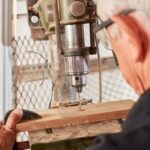Woodworking hand tools are essential for any woodworking project, but their effectiveness greatly depends on their sharpness. Whether you’re using chisels, plane blades, or gouges, a properly sharpened tool not only enhances its cutting performance but also ensures safety and precision in your work. In this article, we will explore the importance of sharpening woodworking hand tools and provide a step-by-step guide to help you achieve the optimal sharpness for your tools.
Properly sharpened woodworking hand tools play a vital role in achieving clean cuts, smooth finishes, and precise shaping. Dull or improperly sharpened tools can cause tear-outs, splintering, and overall poor quality results in your projects. Additionally, working with blunt tools requires more force and effort from your end, leading to fatigue and potential accidents.
In order to obtain the best results from your woodworking projects while ensuring your safety, it is crucial to understand the basics of why sharp tools are important for woodworking. This includes knowing how sharpness affects the tool’s performance as well as understanding the key techniques and materials required for proper sharpening. By mastering the art of sharpening woodworking hand tools, you can elevate your craftsmanship to new heights.
Understanding the Basics
To fully understand the importance of sharp woodworking hand tools, it is crucial to recognize the impact they have on the final product. Whether you are a professional woodworker or a hobbyist, using sharp tools will result in cleaner cuts, more precise work, and ultimately, a higher quality finished piece.
The Benefits of Using Sharp Woodworking Hand Tools
Using sharp woodworking hand tools offers several benefits that directly affect the outcome of your projects. First and foremost, sharp tools make your work easier. With a dull tool, you often have to exert more force and effort to achieve the desired cut or shape. This can lead to fatigue and even injury over time. On the other hand, when your tools are sharp, they effortlessly glide through the wood, making your actions more fluid and efficient.
Furthermore, sharp tools provide greater control and accuracy. When your blades are dull or have nicks in them, you risk losing control over your cuts and compromising the precision of your work. A sharp tool allows for finer details and intricate designs with minimal margin for error.
Improving Efficiency with Sharp Tools
In addition to enhancing the quality of your work, using sharp woodworking hand tools can significantly improve efficiency in your workshop. Sharp blades require less force to cut through wood, reducing the strain on both yourself and your tools. This means less downtime for resharpening and longer periods between maintenance.
Furthermore, sharpened blades allow for cleaner cuts with fewer tear-outs or splinters. This reduces the amount of time spent sanding or fixing imperfections afterward – saving you valuable time that could be better spent tackling new projects.
Overall, understanding the importance of using sharp woodworking hand tools is vital for any woodworker looking to elevate their craft. With enhanced control, improved efficiency, and superior results at stake, investing time into proper sharpening techniques is undoubtedly worth it in the long run.
Essential Tools and Materials Needed for Sharpening
To properly sharpen woodworking hand tools, you’ll need a few essential tools and materials. Having the right equipment is crucial for achieving the best results and prolonging the lifespan of your tools. Here is a list of the necessary items you should have before starting the sharpening process:
- Sharpening Stones: The most important tool for sharpening woodworking hand tools is a high-quality sharpening stone. There are various types of stones available, such as oil stones, water stones, and diamond stones. Each type has its advantages and disadvantages, so it’s essential to choose one that suits your needs and preferences.
- Honing Guide: A honing guide is a handy tool that helps maintain a consistent angle while sharpening chisels, plane blades, and other hand tools. It ensures that the bevel angles are uniform across the cutting edge, resulting in more accurate and efficient sharpening.
- Grinding Wheel or Bench Grinder (optional): If your tools are particularly dull or damaged, you may need to use a grinding wheel or bench grinder to remove excess material before moving on to sharpening with a stone. While not necessary for regular maintenance sharpening, these tools can be useful for initial shaping or repairing heavily damaged edges.
- Lubricant or Water: Depending on the type of sharpening stone you’re using, you may need to use either water or lubricating oil as a coolant during the sharpening process. This helps prevent heat buildup and keeps the stone clean from debris.
- Safety Gear: Sharpening woodworking hand tools can be hazardous if proper safety precautions aren’t taken. It’s crucial to prioritize safety by wearing protective gear such as safety glasses or goggles to protect your eyes from flying debris while sharpening.
Having these essential tools and materials will make your sharpening process much more efficient and effective. Investing in quality equipment upfront will save you time and frustration in the long run while ensuring the longevity and performance of your woodworking hand tools.
Step-by-Step Guide to Sharpening Woodworking Hand Tools
Sharpening woodworking hand tools is essential for achieving precise cuts and improving the overall efficiency of your woodworking projects. This step-by-step guide will walk you through the process of sharpening your woodworking hand tools correctly.
- Prepare your tools: Before you begin sharpening, gather all the necessary tools and materials. You will need a sharpening stone or honing guide, a lubricant such as water or oil, a flattening stone if using waterstones, and a leather strop for polishing.
- Assess the tool’s condition: Examine the cutting edge of your tool to determine its condition. Look for any nicks, chips, or dullness that may require more attention during the sharpening process.
- Prepare the sharpening stone: If you are using a sharpening stone, ensure it is clean and free from debris. Soak waterstones in water for about 15 minutes before use. Apply a few drops of oil to an oilstone if using one.
- Set the bevel angle: Determine the correct bevel angle for your tool. Most chisels have a standard 25-degree bevel, while plane blades typically range between 25 and 30 degrees. Adjust your honing guide accordingly or hold the tool at the desired angle when freehand sharpening.
- Start with coarse grit: Begin sharpening with a coarse-grit side of the stone to remove any imperfections and reshape the cutting edge. Maintain a consistent angle and apply even pressure as you slide the tool back and forth across the stone.
- Progress to finer grits: Once you’ve established an even bevel on your tool, switch to medium-grit and then fine-grit stones to refine the edge further. Repeat the same motion of sliding back and forth until you achieve a sharp edge.
- Check for sharpness: Test for sharpness by lightly running your finger along the cutting edge. Be cautious and use appropriate safety methods. If it doesn’t catch or feel dull, continue sharpening until you achieve a razor-sharp edge.
- Strop for a polished finish: After sharpening, use a leather strop treated with honing compound to polish the tool’s cutting edge. This step will remove any burrs and give your tool an extra level of sharpness.
Remember, practice makes perfect when it comes to sharpening woodworking hand tools. With time, you’ll develop your own technique and find what works best for you and your tools. Regularly maintaining the sharpness of your woodworking hand tools will greatly enhance your woodworking experience and produce better results in your projects.
Table: Sharpening Tools and Materials
| Tools | Materials |
|---|---|
| Honing guide | Sharpening stone(s) |
| Flattening stone (for waterstones) | Lubricant (water or oil) |
| Leather strop | Honing compound |
Sharpening Techniques for Different Woodworking Hand Tools
Sharpening Chisels
Chisels are one of the most commonly used woodworking hand tools, and it is crucial to keep them properly sharpened to maintain their cutting performance. To sharpen a chisel, you will need a combination of coarse and fine-grit sharpening stones or sandpaper, a honing guide, and a leather strop.
Start by securing the chisel in the honing guide at the desired angle. The bevel angle typically ranges from 25 to 35 degrees, depending on the type of woodwork you are doing. Begin with the coarse-grit stone or sandpaper, moving the chisel back and forth across the stone while maintaining consistent pressure. This will help remove any nicks or damaged edges.
Once you have established a clean edge on your chisel, switch to a finer grit stone or sandpaper to refine the edge further. Repeat the same back-and-forth motion but apply less pressure. It is important to maintain a consistent angle throughout this process.
After achieving a sharp edge through the sharpening stones, finish off by stropping the chisel on a leather strop impregnated with polishing compound. This will help remove any burrs left on the blade and give it an extra smooth finish.
Plane Blade Sharpening
To effectively use planes for woodworking, it is essential to regularly sharpen their blades for optimal functioning. Start by removing the plane blade from its housing using a screwdriver or lever cap. Once removed, clean any grime or rust off the blade using steel wool or sandpaper.
To establish an initial bevel on the blade, clamp it securely in a honing guide at an appropriate angle (usually between 25-30 degrees) and begin sharpening using coarse-grit stones or sandpaper. Apply even pressure while moving the blade back and forth across the stone until you can see a clean, polished bevel emerging.
Once the initial bevel is established, progress to finer-grit stones or sandpaper to refine and polish the blade’s cutting edge. Remember to maintain a steady angle and consistent pressure during this process. To achieve a razor-sharp edge, finish off by honing on a leather strop with polishing compound.
Gouge Sharpening
Sharpening gouges poses some unique challenges due to their curved shape. It is crucial to maintain the tool’s curve while sharpening to ensure efficient wood removal without compromising control. One effective method is using slip stones or round tapered files that match the shape of the gouge.
To sharpen a gouge, start by securing it in a honing guide or holding it firmly by its handle. Hold the slip stone or tapered file at an appropriate angle (usually matching the existing bevel) and gently stroke it along the curve of the tool. Maintain consistent pressure and keep rotating the stone/file to match the curvature of the gouge.
Continue stroking until you achieve a polished surface across the entire cutting edge. Finally, hone the gouge on a leather strop with polishing compound for that extra level of sharpness and smoothness.
Remember, practicing these sharpening techniques for different woodworking hand tools will enhance your woodworking experience by ensuring precision, control, and efficiency in your work.
Troubleshooting and Common Mistakes to Avoid during Sharpening
While sharpening woodworking hand tools may seem straightforward, there are common mistakes that can hinder the effectiveness of the process. Understanding these pitfalls and knowing how to troubleshoot them will ensure that your tools are adequately sharpened for optimal performance. Here are some common mistakes to avoid when sharpening woodworking hand tools:
- Incorrect Angle: One of the most common mistakes is sharpening at the wrong angle. Each tool has a specific bevel angle, which should be maintained to achieve optimal cutting performance. Using an angle guide or honing guide can help you maintain consistency while sharpening. Consult the manufacturer’s guidelines or reputable sources for information on the correct bevel angles for different woodworking hand tools.
- Uneven Bevel: Another mistake is failing to maintain an even bevel across the edge of the tool. This can result in an uneven cut and reduced effectiveness. To prevent this, it is essential to evenly apply pressure and maintain consistent strokes throughout the sharpening process. You can use a Sharpie marker to color the bevel before sharpening, making it easier to identify any uneven areas.
- Over-Sharpening: Over-sharpening can weaken your woodworking hand tools by removing too much material from their edges. This can lead to faster wear and tear or even breakage during use. To prevent over-sharpening, start with a coarse grit stone or abrasive and progressively move towards finer grits until you achieve the desired sharpness without removing excessive material.
To troubleshoot these issues, regularly inspect your woodworking hand tools after sharpening them. Check for irregular wear patterns or inconsistencies in the bevel angle across the edge of each tool. If you notice any problems, reassess your technique and make adjustments accordingly.
In addition to troubleshooting, it is crucial to avoid these common mistakes during sharpening sessions by being mindful of your technique and using the right tools. Taking the time to sharpen woodworking hand tools properly will ultimately result in smoother cuts, improved accuracy, and increased efficiency in your woodworking projects.
Tips and Tricks for Maintaining the Sharpness of Woodworking Hand Tools
Properly maintaining the sharpness of woodworking hand tools is crucial for ensuring optimal performance and achieving high-quality results. Here are some useful tips and tricks to help you maintain the sharpness of your woodworking hand tools:
- Clean and Store Properly: After every use, make sure to clean your woodworking hand tools thoroughly. Remove any dirt, debris, or sawdust that may have accumulated on the blades or cutting edges. Use a brush or cloth to wipe off any remaining residue. Once cleaned, store your tools in a dry place to prevent rust and corrosion.
- Regular Inspection: Periodically inspect your woodworking hand tools for any signs of wear, damage, or dullness. Look for chips, nicks, or uneven edges on the blades or cutting surfaces. If you notice any issues, address them immediately by sharpening or repairing the affected areas.
- Avoid Excessive Force: When using your woodworking hand tools, avoid applying excessive force or pressure. Let the sharpness of the tool do the work for you instead of forcing it through the wood. This will not only help maintain the sharpness but also prevent unnecessary strain on both your tools and yourself.
- Sharpening Frequency: The frequency at which you need to sharpen your woodworking hand tools depends on various factors such as usage frequency and type of wood being worked with. As a general rule of thumb, it is recommended to sharpen your tools whenever you notice a decrease in cutting performance or when they start leaving ragged edges.
- Leather Strops: Consider using a leather strop as part of your regular maintenance routine. A leather strop helps remove fine burrs and further polishes the cutting edge, resulting in an exceptionally sharp and smooth finish.
- Honing Guides: For more precise and consistent sharpening results, consider investing in honing guides. These guides help maintain a constant angle during sharpening, making it easier to achieve a sharp and precise edge.
By following these tips and tricks, you can ensure that your woodworking hand tools stay sharp and ready for use. Remember that regular maintenance is key to keeping your tools in optimal condition and prolonging their lifespan.
| Tips | Tricks |
|---|---|
| Clean and Store Properly | Avoid Excessive Force |
| Regular Inspection | Sharpening Frequency |
| Use Leather Strops | Consider Honing Guides |
Enhancing Cutting Performance
Honing, stropping, and polishing techniques are essential for enhancing the cutting performance of woodworking hand tools. While sharpening is necessary to restore the edge of a dull tool, honing, stropping, and polishing take it to the next level by refining and perfecting that edge. These techniques help to achieve a razor-sharp edge and improve the functionality of the tools.
Honing is the process of removing small burrs or wire edges left after sharpening. It involves using a honing guide or jig to maintain a consistent angle while rubbing the tool’s bevel against a honing stone or plate. Honing removes any imperfections and further sharpens the blade, resulting in improved cutting performance.
Stropping is another technique used to enhance the sharpness of woodworking hand tools. A strop is typically made from leather or fabric mounted on a flat surface. To use a strop, apply an abrasive compound (such as polishing paste or honing compound) onto the strop and then rub the bevel of the tool against it in a controlled manner. Stropping helps refine the edge even further, removing any remaining micro-burrs and producing a keen cutting edge.
Polishing is often the final step in enhancing cutting performance. After honing and stropping, it involves using finer abrasives like sandpaper or polishing stones to achieve an even smoother finish on the bevel of the tool. Polishing not only improves cutting efficiency but also reduces friction between the tool and wood, resulting in cleaner cuts.
Safety Precautions and Protective Gear for Sharpening Woodworking Hand Tools
When it comes to sharpening woodworking hand tools, safety should always be a top priority. Accidents can happen when working with sharp objects, so it is important to take proper precautions to protect yourself during the sharpening process. In this section, we will discuss some essential safety measures and protective gear that you should consider using when sharpening your woodworking hand tools.
First and foremost, it is crucial to wear appropriate eye protection. When sharpening hand tools such as chisels or plane blades, small metal or wood particles can become dislodged and fly towards your face. Safety glasses or a face shield can prevent these particles from causing eye injuries. Additionally, wearing gloves will not only protect your hands from potential cuts but also provide a better grip on the tools during sharpening.
Another important safety measure is to secure your work area properly. Make sure that your workbench is stable and secure, with enough space for you to maneuver safely. Avoid clutter around the work area to minimize the risk of accidents. Additionally, always position your body in a way that allows you to maintain control of the tool being sharpened and avoids awkward angles that could lead to slips or injuries.
In terms of protective gear, respiratory protection should also be considered if you are working with materials that produce fine dust particles, such as sandpaper or grinding wheels. These particles can be harmful if inhaled over an extended period of time. Wearing a dust mask or respirator will help filter out these particles and protect your lungs.
By following these safety precautions and using appropriate protective gear, you can ensure a safe and enjoyable experience while sharpening your woodworking hand tools. Remember, taking the necessary steps to protect yourself is just as important as maintaining sharp tools for optimal performance.
Conclusion
In conclusion, mastering the art of sharpening woodworking hand tools is essential for any woodworker looking to improve their craft. Properly sharpened tools not only enhance cutting performance but also ensure precision and accuracy in woodworking projects. By understanding the basics of why sharp tools are important and having the essential tools and materials on hand, woodworkers can follow a step-by-step guide to sharpening their tools correctly.
Additionally, woodworkers should familiarize themselves with different sharpening techniques specific to various woodworking hand tools such as chisels, plane blades, and gouges. This knowledge will allow them to choose the most appropriate method for each tool and achieve optimal results. However, it’s important for woodworkers to be mindful of common mistakes and troubleshoot any issues that may arise during the sharpening process.
Maintenance is key when it comes to keeping woodworking hand tools sharp. By following tips and tricks for maintaining sharpness and incorporating honing, stropping, and polishing techniques into their routine, woodworkers can prolong the lifespan of their tools and minimize time spent on frequent re-sharpening.
Lastly, safety precautions should never be overlooked when sharpening woodworking hand tools. Wearing protective gear such as gloves, goggles, and a dust mask is crucial in preventing injuries from flying particles or accidental slips while handling sharp objects.
Overall, by dedicating time to practice these sharpening techniques and applying them consistently, woodworkers can experience improved cutting performance, increased efficiency in their projects, and a greater sense of mastery over their craft. Sharp tools truly are a game-changer for any woodworking enthusiast seeking professional-quality results.
Frequently Asked Questions
How do you sharpen woodworking tools?
Sharpening woodworking tools is an essential skill for any woodworker, as it ensures precision and efficiency in their work. There are several methods to sharpen woodworking tools, depending on the specific tool. For chisels and plane irons, a common method is using a sharpening stone or a honing guide.
The stone is moistened with water or honing oil, and the beveled edge of the tool is then rubbed against the stone at an appropriate angle until a sharp edge is formed. Sharpening stones come in different grits, from coarse to fine, which allows for initial sharpening to removing burrs and achieving a polished edge. Some woodworkers may also use electric grinders or sharpening jigs for speed and convenience.
What are the appropriate methods to sharpen hand tools?
Hand tools used in woodworking such as chisels, planes, saws, and carving knives can be sharpened using various methods depending on the tool’s design and material. One common method is using a sharpening stone or oilstone to manually rub the blade against its surface while maintaining an appropriate angle. This method allows for precise control over the shaping of the cutting edge based on personal preference.
Another method involves using honing guides that help maintain consistent angles while sharpening by guiding your hand along during the process. Whichever method is chosen, it’s important to regularly inspect the hand tools for any nicks or damage that may require additional attention before proceeding with sharpening.
What does a carpenter use to sharpen his tools?
Carpenters typically use a range of tools in their trade that require regular maintenance and sharpening to ensure optimal performance and longevity. Common tools used by carpenters include chisels, planes, hand saws, and utility knives. To sharpen these tools effectively, carpenters often rely on sharpening stones also known as whetstones.
These stones come in different sizes and grit levels allowing carpenters to choose according to their specific needs at any given time. By dampening the stone with water or honing oil, carpenters carefully move the blade back and forth across the stone’s surface at an appropriate angle to remove any dullness and create a razor-sharp cutting edge. Additionally, many carpenters also use a strop made of leather or cloth impregnated with honing compound to further refine the sharpness of their tools after using sharpening stones.

Hi everyone! I’m a woodworker and blogger, and this is my woodworking blog. In my blog, I share tips and tricks for woodworkers of all skill levels, as well as project ideas that you can try yourself.





